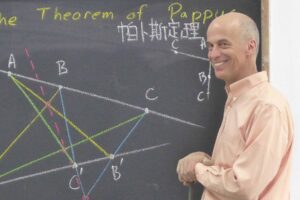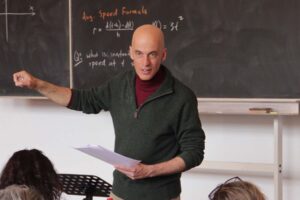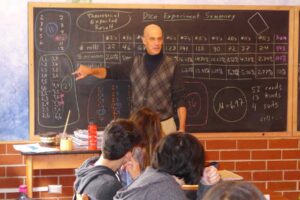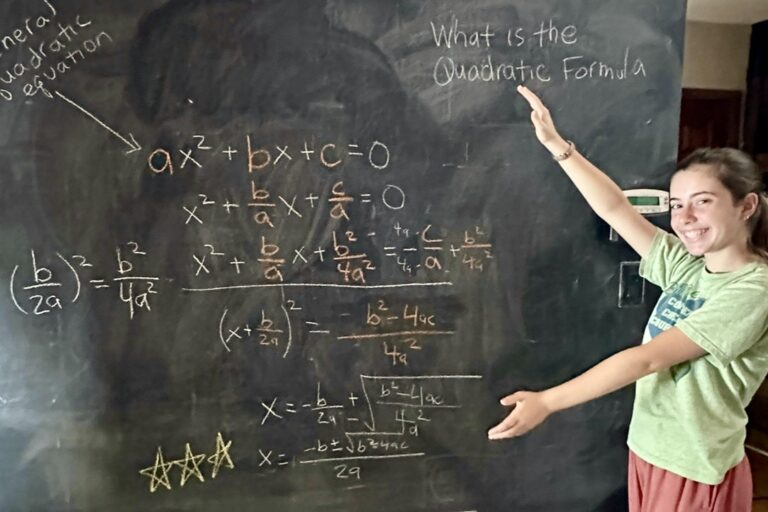For decades in Waldorf schools and families there has been concerned hand-wringing, or passionate defiance, over the ever-deepening intrusion of technology into our lives. We lament society’s fading connection to the natural and spiritual world, as well as between each other.
Studies abound with the dangers of too much ‘screen time’- a term that in my day referred rather quaintly to broadcast television and movies, but now encompasses everything from sleep and mood problems to neck and back pain, brain alterations, destructive emotional hazards of social media, distraction, decreased attention and focus, a weakening of critical thinking, deterioration of the social and family fabric, desensitization, predatory behavior, and all manner of ills.
Online or remote teaching, in today’s world, is intimately linked with technology and screen time. The pandemic of 2020 shocked the world into swallowing modern remote learning like a bitter pill. Schools, especially Waldorf schools, were unprepared, and quickly scrambled to figure out how to implement such systems, with many negative experiences, and a sigh of relief when in-person learning became the norm again.
But is remote learning using online technology something to be rejected out of hand in the Waldorf community? Or can it be carefully wielded as a tool, a resource to further the mission and bring Waldorf teaching to a wider audience?
Online instruction can be a successful tool even in Waldorf learning, but it has to be used appropriately– limiting passive lectures, actively drawing insights and understanding out of the students, allowing for them to connect and work together, and balancing online time with artistic and physical activities that engage with nature, all the twelve senses, and develop wonder for the “real world.”
Steiner on Technology
It’s been well over 100 years since the first Waldorf school opened, and technology has transformed life on earth tremendously since then. But even though the details of the state of the world have changed, it’s worth noting that the impulse to “run and hide” from the modern world, or technology, is precisely something Rudolf Steiner warned against, going so far to call it a “weakness of soul.”
“All desire to withdraw, to protect oneself from the influences of unavoidable world-karma, emanates from weakness … There would be no greater fallacy than to say: We must rebel against what technical science has brought to us in modern life.
The real remedy lies, not in allowing the forces of the soul to weaken and to withdraw from modern life, but in so strengthening these forces that its pandemonium can be endured.” (Steiner)
Art, and Nature, support the soul in the face of modern mechanization, industrialization, de-humanization, but Steiner says that even that art needs to take a different path than in times past. Visit the lectures to learn more.
A Wonderful Servant but a Terrible Master
Arguably, the Waldorf community carries a prejudice, a dogma even, against anything online. It’s an attractive and enticing position to take, born of the genuine and valid concerns mentioned in the opening paragraphs. In the old days we could say, “no screens” and go quite far with that. Today that is very difficult, and beyond a certain age, perhaps ill-advised. Our reality, and the indication from Steiner, appears to be: face this intrusion clear-eyed and with spiritual fortitude, develop inner spiritual forces in proportion to the outside pressure of modern life.
There is an old Asian proverb (widely misattributed to various modern authors), “The mind is a wonderful servant but a terrible master.” The same can be said of technology. And this in fact is the rub… how to benefit from the convenience, efficiency, reach, and power of the technology while remaining its master?
 Douglas Gerwin reminds us that outcries over advances in technology go way back. According to Soccrates, the Egyptian king Thamus considered writing itself a threat, that men would “cease to exercise memory … calling things to remembrance no longer from within themselves, but by means of external marks.” (Gerwin) The printing press led to the rapid growth of literacy, but challenged the Church and exposed the public to uncensored material as well as misinformation. The simple calculator is a handy tool to the adult, but undermines the young child’s development.
Douglas Gerwin reminds us that outcries over advances in technology go way back. According to Soccrates, the Egyptian king Thamus considered writing itself a threat, that men would “cease to exercise memory … calling things to remembrance no longer from within themselves, but by means of external marks.” (Gerwin) The printing press led to the rapid growth of literacy, but challenged the Church and exposed the public to uncensored material as well as misinformation. The simple calculator is a handy tool to the adult, but undermines the young child’s development.
Gerwin’s article is playfully named “The Sorcerer’s Apprentice: Mind over Machinery,” and nods to Goethe’s 1797 poem, “Der Zauberlehrling,” (The Sorcerer’s Apprentice) about a wizard’s apprentice who learns the hard way that magic is not to be trifled with. You probably recognize the Disney version with Mickey Mouse. Technology is magic, at least in that it continually appears to perform supernatural feats.
The word technology comes from the Greek techne and suffix ology, which combine to mean “the practical application of knowledge.” Even Plato thought of techne as dangerous in its virtues. Arts such as paintings and sculptures were considered unvirtuous because of their third-hand representation of true absolute reality and beauty.
Gerwin puts it this way: the root meaning of technology implies something about tools or instruments, and something about the way to use them. “You need first to develop a measure of skill to carry out on your own the physical or mental deed that the tool is intended to make easier.” (Gerwin)
Using the computer to create visual and auditory portals to other people ‘flattens’ the experience of our fellows, and furthermore, puts us in a passive, even sleepy state. Interactions we have in person include all our senses, we perceive subtle cues, and remain alert to those around us. Physical proximity may encourage a more free flow of dialogue. So given the limitations and drawbacks of the online medium, it is crucial that we strengthen our inner alertness, call up the impulse to act, to “unmute” and chime in, to remain attentive even as the medium may drag us into passivity. As we’ll see, it’s also the responsibility of the teacher to design around this.
Educating: steadfast but flexible
The traditional classroom is no less prone to bad teaching than a Zoom call, and care must be taken to enliven the “chalkboard lecture” as much as an online one. There is a place for using an online medium to connect diverse homeschool students from around the world in a well-designed, thoughtfully-executed online space, while remaining conscious of the limitations and augmentations necessary to create a holistic, healthy learning environment.
Technology is a tool. In this case, it is simply a way to visually and aurally connect people at a distance, to provide instruction. Education is the development of capacities within the student, summoning forth something they have inside or build within themselves. The art of educating needs to remain flexible, responsive, alert to the world, while steadfast in principle and soul, no matter the environment or medium.
Increasingly, families are choosing homeschooling, sometimes because they lack access to a local Waldorf school or can’t afford the tuition. But often by middle or high school, those parents reach the limit of their comfort in subjects like math, their students may simply need or want some diversity in teachers, or to connect with peers. A flexible solution is to incorporate online teaching, access to some of the best Waldorf teachers in the country, while remaining faithful to the principles of Waldorf education.
Forced online learning, from an initial ‘nightmare’ to an embrace
Appearing in the midst of the global pandemic, a very informative issue of the Research Bulletin, by the Research Institute for Waldorf Education, was devoted to articles speaking directly about online teaching.
It’s no surprise that teachers and students experienced challenges, even ‘disasters’ when abruptly sent home during COVID. The youngest students were surely hit the hardest. My own daughter was in first grade when she had to switch to online learning from home, absolutely antithetical to what I believed about her education. Also, we as a whole demonstrated our resiliency, overcoming challenges and making it through. Trial and error, careful observation of the students’ work, moods, and progress were essential in steering through the mess. The teacher was no longer in charge of the space, the classroom was now fractured, scattered to bedrooms, dining tables or the living room couch.
David Sloan, my high school English teacher from Green Meadow Waldorf School, penned an article in the Bulletin on his experiences, observations, and mishaps while attempting to teach through the finicky tunnel of Zoom. “I realized that many of my hard-won strengths as a classroom teacher would be neutralized … I felt blundered, hamstrung, ineffectual.” (Sloan)
Verbally, he told me his preliminary perspective was that it was a nightmare. As a side note, he also told me that even that nightmare was preferable to teaching in-person but masked!
However, he tried it again, through the Jamie York Academy, where he found a “terrific” experience, specifically in two ways: amazing diversity – students from India, the UK, Hawaii, and across the US (including Alaska) – and students who were really motivated to learn. This, I am learning, is a hallmark of many homeschool students. His more recent experience with the Jamie York Academy led him to sign on for two more such remote learning blocks.
Intentional online learning – The Jamie York Academy
Also appearing in that Research Bulletin from 2020 is an article by Jamie York with insights into how he navigated the treacherous landscape of teaching online as a “Waldorf educator through and through.” In response to a request from a homeschool family to create an online math course, he faced hard questions about how to do it best. How do we maintain engagement knowing that watching a screen puts our brains into sleep mode? How do we build genuine connection through a little square on a screen? Clearly the teaching had to be different, it could not just be classroom teaching over Zoom.
Jamie reminisces that in a conventional classroom, one can float from a story or a bit of lecture to some artistic activity, some group discussion, maybe a brief assessment. But online teaching makes such fluidity much more difficult.
“When teaching online, we need to severely limit the amount of “Teacher Talking Time”. I like to tell myself that, when teaching students online, I have to “snap them awake” every five minutes. Additionally, we need to find multiple ways to have students regularly connect with one another. In an online educational world, students hunger even more to connect with their classmates.
Group work is the “heart and soul” of my program. This is what the students are longing for – connection with their peers. Twice per week my students get together in small groups and engage in meaningful learning – working on math puzzles, solving problems, and discovering mathematical properties…
Surprisingly, I can now look back and honestly say that it has been my most successful year of teaching in my 35-year career – measuring success largely by my students’ enthusiasm and the development of their thinking.” (York)
The Jamie York Academy found a way to implement new strategies and rhythms, leveraging the benefits of recorded lectures, blending them with live teaching and most importantly, live student working groups. The parents are also a critical partner in this model, and are responsible for providing the counterbalance to the necessary screen time with art, movement and activities that connect students with their world.
Successful online teaching and learning requires vigilance, here are some tips:
- Don’t talk so much! Teachers need to limit the amount of teaching talking time.
- Snap students awake every five minutes. Just like in a classroom, teaching needs to be dynamic and engaging.
- Compartmentalize the teaching. Recorded lectures are effective for conveying some things. Supplement that with small group work and individual assignments.
- Less is more. Again, as in classroom teaching but even more so online, let go of the expectation to get through a lot of material.
- Find balance. Take breaks from the computer. Parents need to help counteract the negative effects of screen time with movement, artistic activity, and time outside in nature. Create healthy rhythms and routines, sleep and eat well.
- Intention counts. Keep a good attitude, bring a smile to the work, find the gift in the situation. Even though the group meets by computer screen, it’s a group that otherwise could not. Use your inner ability to find the depth of the relationships despite the limitations of the screen.
Steiner, Rudolf. “Technology and Art: Their Bearing on Modern Culture, GA 275.” The Rudolf Steiner Archive,
https://rsarchive.org/Lectures/19141228p01.html
Gerwin, Douglas. “The Sorcerer’s Apprentice.” Jamie York Academy,
https://jamieyorkacademy.com/the-sorcerers-apprentice/
York, Jamie. “A Year of Online Teaching (2020).” Jamie York Academy,
https://jamieyorkacademy.com/reflections-on-a-year-of-online-teaching-2020/














